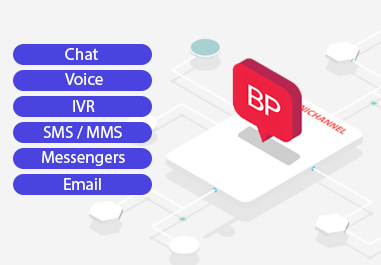Among business executives, 64% consider customer service crucial to their firms’ growth. Customers expect top customer service from all channels when doing business with you. If you can’t deliver, they’ll turn to a competitor. Omnichannel quality assurance is the key to keeping your service on point. In this article, you’ll learn what it is, its benefits, and how to do it properly.
What Is Omnichannel Quality Assurance?
Omnichannel quality assurance (QA) is a process for ensuring an organization’s services are up to standard across every medium. Contact centers use QA to identify customer problems and ensure a positive, consistent experience during every encounter. What sets omnichannel quality assurance apart from traditional quality assurance systems is the ability to monitor 100% of all interactions on every channel depending on the platform you use. This gives you a more comprehensive view of the call center.
Analyzing a contact center’s interactions is complex, so effective QA requires a proven framework. This framework may include:
- Your goals
- Data you need to collect
- How you will assess interactions
- What you will do with the results
Benefits of Omnichannel Quality Assurance
Omnichannel quality assurance improves your contact center experience holistically. Investing in every aspect of your omnichannel customer service enables both customers and agents to thrive. Traditional quality assurance that relies on sampling is not enough to monitor the full customer interaction in a contact center, and is prone to leaving holes in the QA process. According to a study done by Bright Pattern, voice is the channel that is traditionally monitored by most companies. But this is not enough, because less than 1% of voice interactions are measured. This means most interactions are not measured for quality. Furthermore, in the same Bright Pattern study, it was shown that only 33% of companies are able to monitor the entire customer journey from start to finish, and that technology held back the ability for companies to monitor the entire customer journey from start to finish through all channels.
In the same study, it was shown that 85% of companies monitor voice channels, but the number drops drastically for other channels. Only 56% of companies monitor email, 29% monitor webchat, 19% monitor social media, and every other channel is less than 10%. With an omnichannel quality assurance system, companies can reap the benefits of an advanced monitoring system and monitor the whole customer journey. Here are the benefits of an omnichannel quality assurance system.
Better Agent Experience
Due to the stress of dealing with frustrated customers, call centers have a high employee turnover. Quality assurance boosts staff morale by creating a more efficient environment for everyone.
Greater Productivity
QA programs boost productivity by streamlining call center processes.
To illustrate, metrics used in quality assurance help identify areas where you can increase efficiency. KPIs such as average resolution time and call abandonment rate reveal workflow improvement opportunities.
Over time, your support outcomes will improve as you eliminate inefficiencies and shortcomings. This results in a higher level of customer satisfaction and an overall greater return on support expenditures.
Higher Customer Retention
Customer loyalty is the most tangible result of omni quality assurance.
Effective QA eliminates the frustrating support experiences driving customers away. Its ultimate goal is to make agents feel confident and equipped to handle any difficulties thrown their way.
In addition, better support outcomes build brand loyalty. After a positive support experience with your company, customers instantly understand they can rely on you to solve their problems quickly.
Even if a competitor releases a superior product to yours, customers will be reluctant to abandon the support they’ve come to rely on from you.
Effective Data Capture and Analysis
Quality assurance starts with effective data analysis. It shows where you’re succeeding, where you’re failing, and how your progress stacks up. By improving QA, you’ll inevitably develop an effective process for capturing data.
Omnichannel analytics solutions don’t need a lot of technical knowledge. When your contact center automates data capture, you can easily get a holistic view of its success.
Tips on Staying Current With Omni Quality Assurance
Having seen the benefits of omnichannel customer service QA, you’ll now learn how to apply it effectively.
Make Use of AI
AI is one of the most ipmortant tools to ensure an effective omnichannel quality assurance system. AI can be used to monitor all interactions for sentiment, and be used to conduct comprehensive CSAT surveys.
Search Through Interactions Based on Sentiment
Interactions, depending on the platform, can be searched for sentiment and specific details. The information gained from reviewing interactions based on sentiment can then be used for agent coaching and scoring. This scoring can be made very accurate through the use of screen and voice recordings by a supervisor or administrator.
Make a Single Person Accountable
In the thick of the contact center, it’s hard to pinpoint QA responsibilities. Who’s responsible for tracking agent performance? Who implements new improvements?
Instead of giving blanket responsibility to your entire call center staff, appointing a QA leader to manage the process is far more effective. QA leaders can monitor calls, conduct workshops, or do side-by-side coaching to assess an agent’s performance.
A dedicated QA leader also creates a contact point for service workers to approach for assistance. Whenever workers notice a pattern in customer behavior or encounter a situation they aren’t sure how to handle, they approach the QA leader without hesitation.
Have Clear Quality Standards
The criteria you use to measure call center success are crucial for keeping quality standards. Aside from tracking key performance indicators, you must monitor how agents handle angry callers and comply with regulations.
Make sure agents have a clear understanding of what’s expected of them. Providing guidelines in the form of a manual or document is an excellent way to do this. Whenever they’re unsure about a decision, they’ll have a clear point of reference.
Give Quality Feedback to Agents
The best way to give feedback to agents isn’t always clear in most contact centers. Some do it infrequently, not constructively, or too generically to be useful. Here’s how to provide effective feedback for omni customer service:
- Provide consistent feedback. When you don’t give feedback often, agents develop bad habits. Effective QA consistently monitors agent interactions and gently corrects errors.
- Balance praise and criticism. Effective feedback is critique tempered by praise. Aside from boosting their morale, praise helps them know their strengths.
- Keep criticism constructive. It won’t help to give someone an earful when they make a mistake. Keep your feedback calm, friendly, and focused on fixing the problem.
Collaborate as a Team
QA comes from the bottom up, not the top down. Each step of the process involves identifying and improving shortcomings as a team.
Having a collaborative team gives everyone a chance to learn from each other. Not only does everyone bring different skills, but they also handle different situations each day. By unifying your team, they’ll share this information amongst themselves as a knowledge pool.
Don’t Micromanage
Many contact center workers instantly associate “quality assurance” with “micromanagement.” Micromanagement is a huge mistake. It takes the powerful, constructive force of QA and turns it into a dreaded experience grinding worker morale into dust.
Some managers view QA as an occasion to badger workers for small oversights. This often happens when support companies wait for serious issues with contact center productivity to manifest before they aggressively use QA to fix them. Agents become targets when managers attempt to pin their own failure to address issues proactively on them.
The solution is to use QA proactively. Instead of solely relying on it when issues arise, managers should always use it. This way, QA is always gently pushing the whole contact center towards a happier and more productive environment.
Omnichannel Quality Assurance Is Crucial
Omnichannel quality assurance benefits customers and agents alike. Customers enjoy better support outcomes, and agents enjoy more productive work environments.
But as powerful as QA can be, it’s only as good as the contact center platform it relies on. For a unified support experience with true omnichannel tracking, schedule a demo with Bright Pattern today.





